Home » Landscaping Rocks
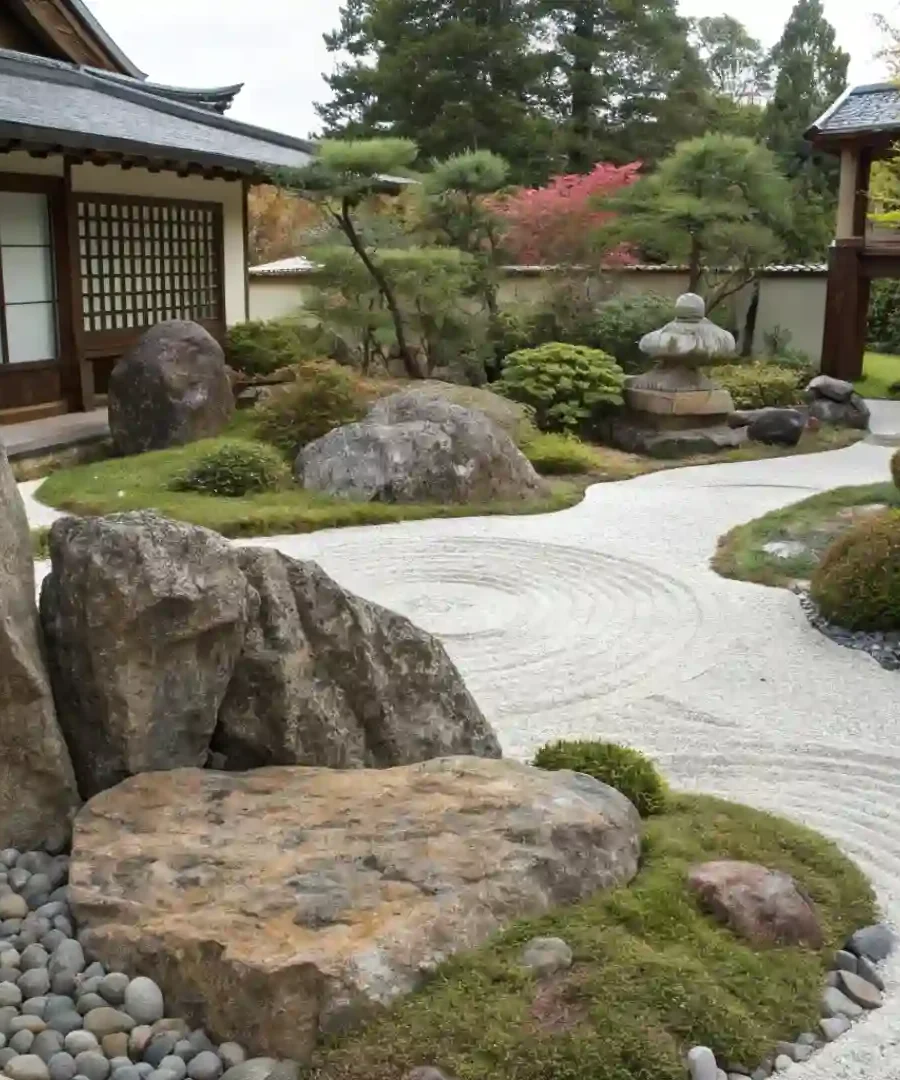
Landscaping Rocks
Landscaping Rocks: Functional Gems in Your Garden
For countless years, gardening aficionados have been employing rocks to take their landscapes to stellar aesthetic levels. As functional forms, rocks have stood the test of time in harmoniously merging visual flair and practicality. Moreover, providing a fillip to the color, texture, and durability of a garden or yard, these gems truly succeed. Whether in a minimalist Zen garden or a vivid, multi-level landscape, rocks effortlessly pave their way to create spaces of art. Furthermore, they can offer both structure and striking visual contrast. So, come, and let us explore various types of rocks, innovative design concepts, and useful tips to assist you in selecting and maintaining the perfect stones for your outdoor environment.
Video Credit: PlantDo Home & Garden
PlantDo is here to give you home garden and home decor ideas. Here, you will find what you have been looking for. Watch this video to get inspired!
Why Use Landscaping Rocks?
Functional and beautiful, rocks control soil erosion for the well-being of your loved garden.
Enhancing Visual Appeal and Textural Contrast with Landscaping Rocks
River stones, polished by nature, sit beautifully with your green surroundings. Likewise, the rugged lava rocks accentuate your prized succulents. Additionally, the tactile quality of interplay, charm, and texture of landscaping rocks cannot be achieved by flower beds alone. Consequently, they can transform any garden into a piece of art with creative use.

Rocks: A Low-Maintenance Solution
With minimal maintenance required, such as occasional weed removal, they largely manage themselves. Furthermore, stones can replace mulch and grass, as they hardly need to be trimmed or replaced. Consequently, this quality makes them the perfect choice for zones with limited water or busy homeowners.
Drainage and Erosion Control
Soil stabilization and flow reduction can be achieved by positioning rocks on embankments or slopes. Moreover, lava rocks or gravel help bring down the formation of water pools and maximize drainage. This factor is especially helpful in places with high moisture levels, thereby preventing root rot in plant beds.
Landscaping Rocks: Common Types
River Rocks
- Appearance: These rocks are blessed with rounded edges, a smooth texture, and earthy tones as they blend into varied landscapes seamlessly.
- Uses: They are at their best in edging pathways, highlighting borders, or in the design and nurturing of dry creek beds. Rocking and rolling with function and charm.
- Consideration: They can be a little more expensive as they are sourced from riverbeds.
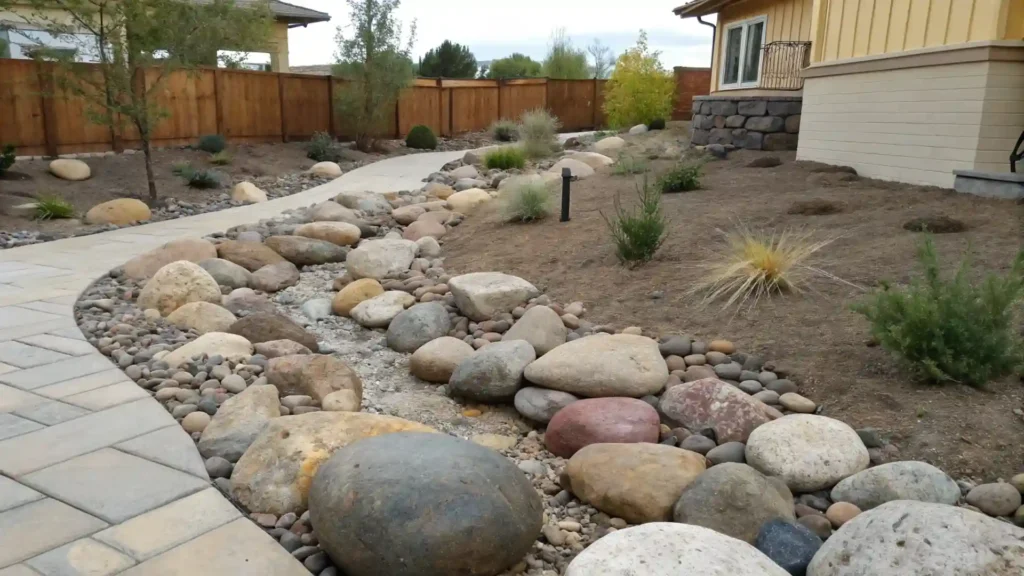
Crushed and Gravel Rocks
- Appearance: To begin with, these rocks are semi-geometrical in shape and angular in form. They come in a variety of colors, ranging from gray to buff, making them versatile in design applications.
- Uses: For example, they are ideal for pathways, driveways, or as fillers in large landscape areas. This dual functionality—practical and aesthetic—makes them a popular choice in both residential and commercial gardens.
- Consideration: However, these rocks may gradually scatter or shift from their original placement. As a result, using a border or edging is recommended to secure their position and preserve the intended structure.
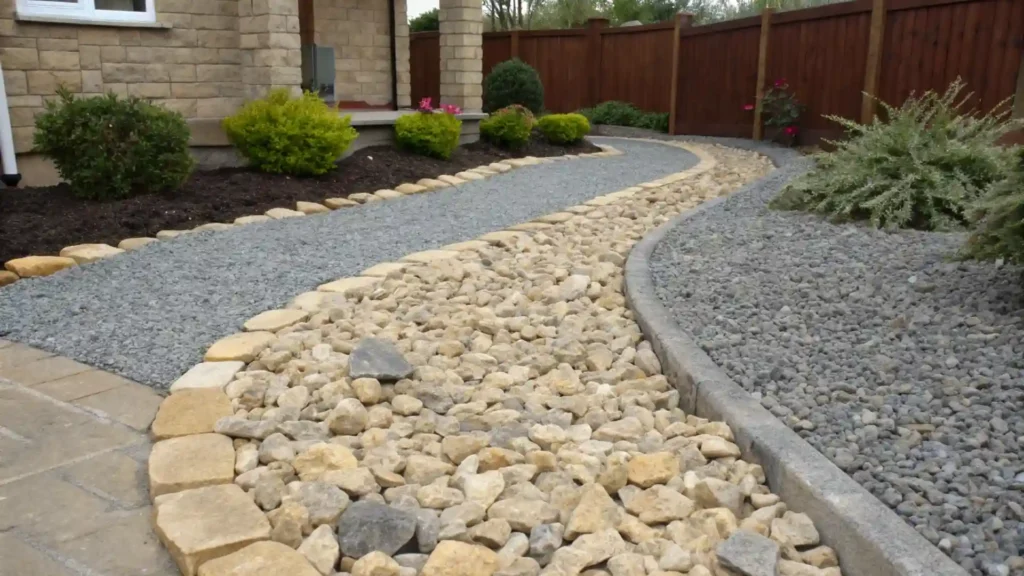
Lava Landscaping Rocks
- Appearance: To begin with, this material is notably sculpturesque, available in red or black shades. It is characterized by its porous and lightweight nature, giving it both visual appeal and functional benefits.
- Uses: Additionally, it excels at maximizing drainage and insulation, making it an excellent mulch replacement around plants. This makes it particularly useful in areas where proper soil moisture retention and temperature regulation are key.
- Consideration: However, due to its lightweight nature, it can be prone to scattering in windy conditions, especially in open areas. Therefore, it is advisable to use it in sheltered spots or combine it with other materials to prevent displacement.
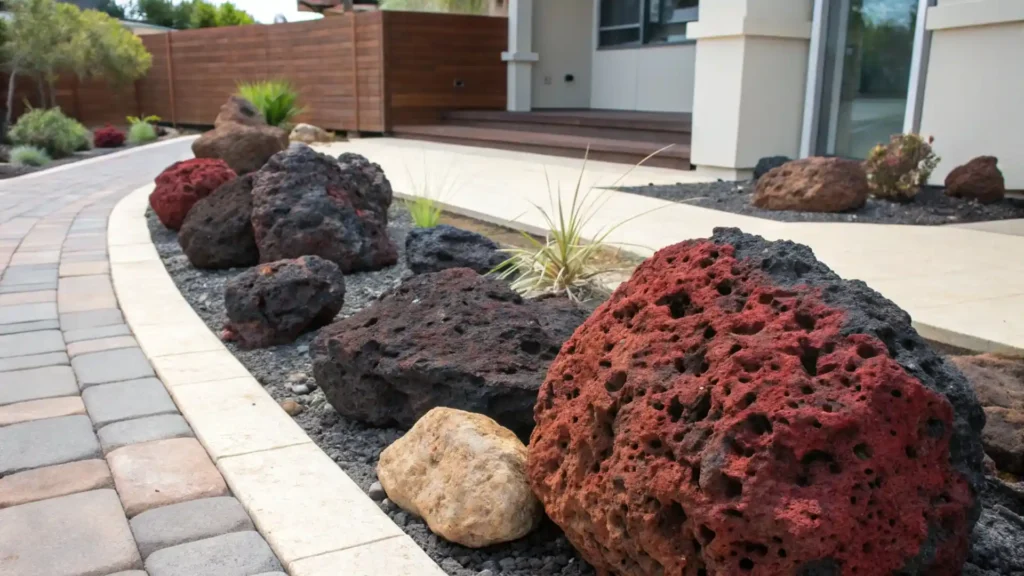
Flagstone and Slate
- Appearance: To begin with, these rocks have arresting looks, with sizable, flat forms in a color palette of browns, grays, or intriguing blues. Their striking appearance makes them stand out in any setting.
- Uses: Additionally, their unique appearance can jazz up the structure and charm of any landscape, whether used as patios, stepping stones, or ornamental focal points. This versatility adds to their appeal in diverse garden designs.
- Consideration: However, due to their larger size, installation can be more labor-intensive. As a result, it requires extra effort and precision to ensure proper placement and long-lasting results.

Boulders
- Appearance: Undoubtedly, these rocks make massive, bold statements in any yard. Moreover, their shapes vary from rounded to jagged, adding both character and drama to the landscape.
- Uses: Additionally, they are ideal for designer rock gardens, serving as anchors at corners or for effectively delineating borders. Their boldness enhances the visual appeal and structure of any garden design.
- Consideration: However, it could be a costly affair, as heavy machinery may be needed for their movement and placement. Therefore, it’s important to factor in the additional costs of equipment and labor when planning for these rocks.
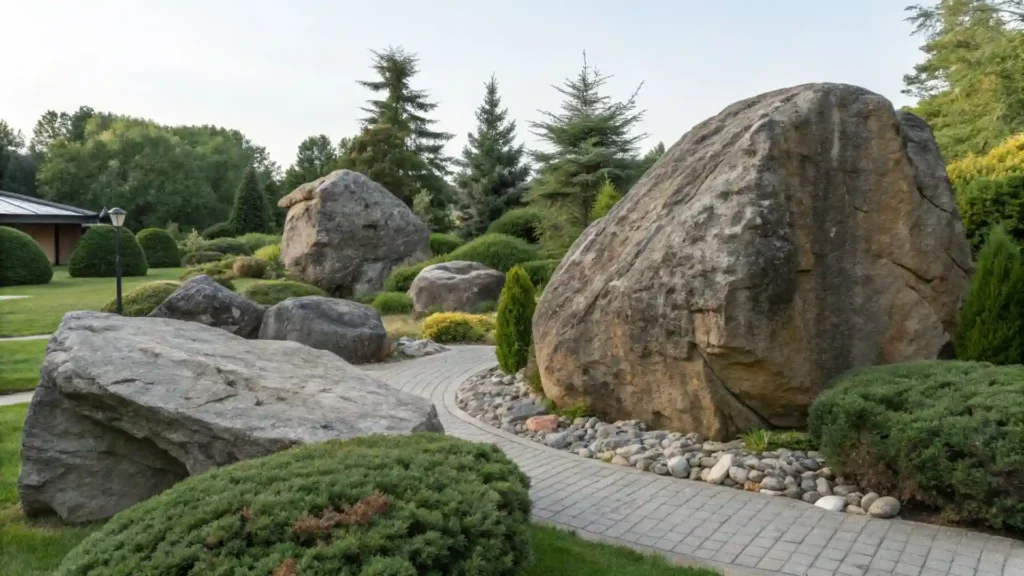
The Right Rock for Your Landscape
Climate and Soil Considerations
- Arid Regions: For hot, dry conditions, crushed stones or lava rocks are excellent. Moreover, they help retain minimal moisture, making them perfect for conserving the little water available in such environments.
- Rainy Areas: In contrast, to avoid waterlogging, drainage-friendly river rock or gravel is the right choice. Consequently, excess water drains efficiently, preventing potential damage to plants or soil erosion.
Size and Color Harmony
- Design Harmony: When choosing rocks, opt for earthy hues if your home features warm tones to complement the overall aesthetic. Similarly, ensure the colors blend naturally with the surroundings to create a cohesive and inviting landscape.
- Scale Determination: Small stones in an expansive yard can look weak and scattered, detracting from the overall design. Likewise, huge rocks in a small yard might become overwhelming, disrupting the balance of the space.
Functional vs. Decorative Purposes
- Functionality: These rocks serve as great erosion controllers, drainage facilitators, and gravel for driveways. Additionally, they enhance stability and durability, making them practical choices for various landscaping needs.
- Decorativeness: Furthermore, they are ideal as focal points, boulders, polished pebbles, or flagstones, making them a landscape designer’s go-to rocks. They not only provide functionality but also add aesthetic appeal and texture to any landscape design.
Incorporating Rocks into Your Design
Rock Gardens and Zen Spaces
Cacti, succulents, and ornamental grass can all harmonize with a melange of rocks in various sizes and shapes to create a retreat flowing with a serene, minimalist ambient aura.
Pathways and Walkways
Gravel or stepping stones create inviting and practical paths through the garden. Additionally, adding edging helps keep the stones in place, while incorporating lighting enhances the nighttime ambiance.
Mulch Replacements & Borders
Swap organic mulch for decorative stone around shrubs and flower beds. Unlike wood mulch, it won’t break down over time, thereby reducing the need for frequent top-offs.
Maintenance and Care
Weed Control Strategies
Though rocks reduce weeds, they’re not foolproof. Apply a landscape fabric beneath stones to minimize unwanted growth. Occasionally, handpick any weeds that sprout on top.
Refreshing the Surface
The look of rocks may become dull over time with the collection of debris and dust on them. However, a brisk rinse with a water hose and gentle power washing can swiftly bring them back to their glorious self. In fact, regular maintenance can help preserve their beauty for years to come.
Long-Term Durability
Rocks of high quality can last for years and decades. If you notice sinking and shifting, re-level the spot. These issues crop up especially after heavy rains or freeze-thaw cycles, so keep a vigil.
Budgeting and Sourcing Rocks
Local Quarries and Garden Centers
Purchase bulk materials from quarries if you have a larger project. Garden centers offer smaller quantities, often bagged for convenience.
Bulk vs. Bagged Purchases
- Bulk: Bulk rocks are more cost-effective for significant areas, though you may need a truck or delivery service to transport them. This makes them a great option for larger landscaping projects.
- Bagged: On the other hand, bagged rocks are easy to transport but tend to be pricier per pound. They are ideal for smaller projects or for adding finishing touches to a landscape design.
Transportation and Delivery
Rocks are heavy, so factor in delivery costs or the need to rent a suitable vehicle. Make sure you have somewhere safe to offload them upon arrival.
Environmental Considerations
Sustainable Rocks Choices
Try to source recycled or reclaimed stones from construction sites as an eco-conscious choice. Moreover, local sourcing of rocks will substantially reduce the carbon footprint from transportation.
Native and Local Materials
Create a garden that is aesthetically harmonious, but pocket-friendly too. Source rocks naturally found in your area to help your landscape blend beautifully with the local environment.
Real-Life Inspiration and Use Cases
Small Urban Gardens
Create a functional and visually appealing rooftop terrace garden or a cozy courtyard. Additionally, small boulders or gravel will help you create more such beauties on a smaller scale.
Landscaping: Coastal and Desert Vibe
Sandy-colored rocks, driftwood, seashells, or cacti complement smooth pebbles. Furthermore, incorporate drought-tolerant plants like agave or aloe for pops of green magic.
Water Features and Dry Creek Beds
A koi pond or an artificial waterfall will start looking fabulous with river rocks or smooth pebbles arranged around it. Moreover, a dry creek bed directs rainwater in rainy zones. Creatively arrange smaller gravel and large rocks in and around it to resemble a natural stream.
Landscaping Rocks Quiz
1. Which type of landscaping rock is best known for enhancing drainage and resisting water accumulation?
Flagstone
Lava rocks
Boulders
Polished pebbles
2. Which type of landscaping rock is best for creating walkways or patios due to its flat, smooth surface?
Lava rocks
Flagstone
Boulders
Polished pebbles
3. Which rock type is often used for decorative ground cover and features a smooth, shiny surface?
River rocks
Flagstone
Polished pebbles
Lava rocks
4. What type of rock is typically used in large landscaping features such as retaining walls and rock gardens?
Polished pebbles
Lava rocks
Boulders
River rocks
5. Which rock is known for its vibrant colors and is commonly used in decorative landscaping?
Crushed granite
Lava rocks
River rocks
Flagstone
Summary
Rocks add timeless elegance and practicality to landscapes. In addition, they prevent erosion, enhance drainage, and complement succulents or pathways. For instance, lava rocks suit arid climates, while river rocks aid drainage. Moreover, when used as mulch, they reduce maintenance. With careful placement of sizes and colors, rocks can transform any yard into a stunning, low-maintenance retreat.
FAQs
1. Can I combine various types of rocks in one zone for visual appeal?
Absolutely! Smooth river stones combined with rough gravel in layered textures can create a stunning result.
2. How can I secure rocks from sinking into the soil over time?
Avoid excessive settling, mostly during rains by laying a stable base and using landscaping fabric.
3. Is the placement of rocks around trees advisable?
Yes, you can. However, consider the plant species as the roots of a few plants can get stressed by heat-capturing rocks. Do not forget to leave a few inches of space around the trunk for airflow wherever you place them.
4. Will large boulders require professional installation?
Often, yes—boulders can be extremely heavy and may need special equipment for safe placement. Alternatively, you can tackle smaller boulder projects with a sturdy dolly or team help.
5. Are colored glass rocks suitable for outdoor landscaping?
They can add a vibrant, contemporary flair, but ensure they’re tempered glass designed for outdoor use. Unprotected glass can fade in sunlight or pose a cutting hazard if broken.
Trending Post
Large Indoor Plants, Guest Bedroom Ideas, Leather Sectional, Outdoor Plant Stand Ideas, Hydroponics Farming, Minimalist Home Decor Ideas, Outdoor Plant Stand, Aquaponics Farming, Alternative Home Decor Ideas – Think Laterally, Summer Plants, DIY Vertical Garden, The Benefits of Closed-Loop Gardening, Diy Gardening, Sustainable Materials, Garden Hoe, Gardening as Therapy, Permaculture, Muhly Grass Care, Wheelbarrow, DIY Garden Ideas, DIY Greenhouse, Cheap DIY Garden Path Ideas, DIY Garden Fence, Snowball Bush, Sustainable Design, Sustainability and Home Decor, Small Kitchen Table Sets For 4, Outdoor Sectional Couch, How To Care For a Peace Lily Indoors, Plant Stand Indoor Walmart, Plant Stand Indoor With Grow Lights, Plant Stand Indoor Tall, Plant Stand Indoor Amazon, Kitchen Decor, Plant Stand Indoor, Snake Plant Benefits, Kitchen Decor Ideas



Pingback: Craftsman Lawn Mower - ytvblog.com
Pingback: Majesty Palms - ytvblog.com
Pingback: Dicot